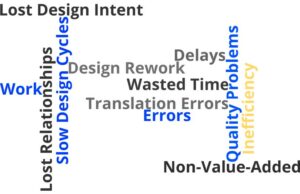Multi-CAD Means Mayhem
Does this sound all too familiar?
• We spend hours working on suppliers’ designs before we can do any real value-added work
• We waste time re-importing design changes from partnersand still have to redo all of our modifications like adding ribs or creating tool paths
• The engineering firm that does our advanced FEA faces the same inefficiencies with our files
• Our industrial designers need features that aren’t supported by our design engineers’ CAD
• We have to rework every design before we send it to the shop floor
• We have years of effort and knowledge in old CAD files so we have to pay for licenses, but we still end up remodeling for the next revision
• We want to move CAD to the cloud, but we’re don’t want to leave our IP behind on the desktop
• We can’t afford to retrain all of the engineers from the company we just acquired and migrate them to our “primary” CAD tool
Multi-CAD leads to significant non-value-added work. Given the unavoidable reality of multi-CAD, there should be a better way to manage the mayhem without wasting so much time. Let’s take a look.

CAD Interoperability Issues in a Nutshell
Proprietary CAD data formats typically don’t work well with CAD tools other than the one that created them. Why is this? It’s not the tools, it’s the way the geometry data is stored. CAD software vendors invest in building highly capable tools to help their customers develop innovative designs. They can’t afford to compromise capabilities for a standard that works just as well across every CAD tool.
CAD vendors try to help customers by investing in import and export of standard, interoperable formats. But those formats sacrifice communicating detail, features, and design intent. “When we create outputs for our manufacturing equipment we may be able to transfer geometry but we lose a lot of information,” explains Steelcase Senior Consulting Applications Engineer for Global Product Visualization Technologies, Stephen Goetzinger. “The volume of rework in our area is massive,” he adds.
CAD imports and exports frequently don’t import information completely. “We ended up redrawing a fair number of designs. We would bring in a file and lines didn’t always connect, we had to go around the perimeter and fix the breaks, and some of the radiuses weren’t really radiuses,” shares Mike Elsholz of Steelcase.
The Conundrum
We want the best tools available, but we want them all to work together. The hard reality is that we can’t have both. But engineers have to get the job done despite the challenges.